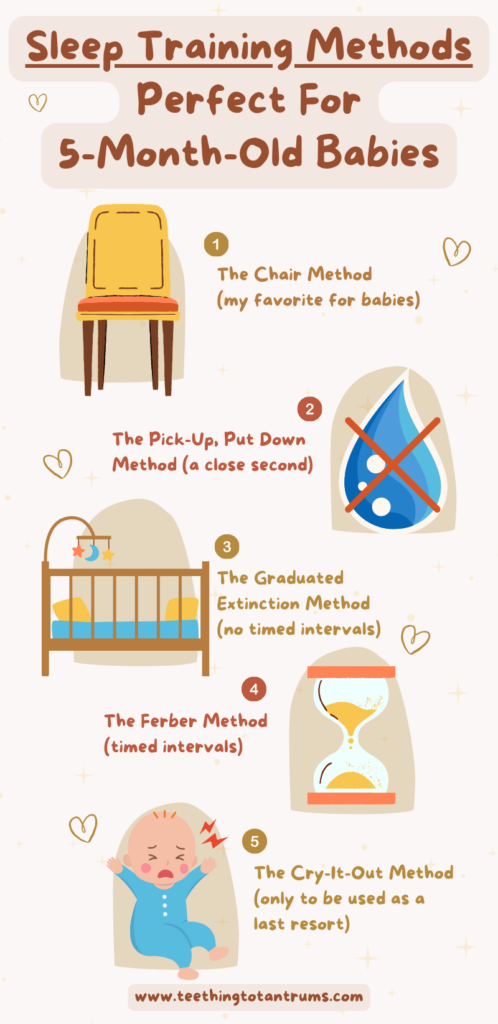Sleep training 5-month-old babies involves teaching your little one healthy sleep habits that will help them fall asleep on their own and stay asleep throughout the night for years to come.
But there’s more to 5 months sleep training than meets the eye…
After 40 years as a Norland Nanny specializing in sleep issues, I’m here to share all I know about sleep training babies so you are guaranteed success with your little one.
So, without further ado, let’s get into it.

Table of Contents
What Is Sleep Training?
Sleep training is the art of teaching your baby to self-soothe, fall asleep independently, and create and maintain healthy sleep habits as they grow. During the process of sleep training, you help your 5-month-old return to sleep on their own if they wake up during the night.
When Can You Start Sleep Training A Baby?
The AAP recommends that you start sleep training when your baby is at least 4 to 6 months old.
This is because at this age, babies begin to develop a regular sleep-wake cycle and some can start to drop night feedings.
However, not every baby will be ready to sleep train so early on in their development. Every baby has a different temperament which will need to be taken into account too.
Keep ready to learn whether sleep training is suitable for your 5-month-old baby.
Can You Safely Sleep Train A 5-Month-Old?
Yes, you can safely sleep train at 5 months old. However, you must look for signs of readiness, like settling into a more predictable sleep pattern and eating at regular intervals before you begin.
And you must remember that “sleeping through the night” will still include night wakings and feedings for several months.
Consulting your pediatrician is also a wise first step when considering embarking upon sleep training. They understand your baby’s development and health and can indicate whether they feel the time is right for you to start.
Regardless, there are things you can do right now that will help prepare your 5-month-old for sleep training (and may stop you from ever needing to sleep train at all!)
Looking to get your little one to sleep quickly and effortlessly? Check out my Bedtime and Nap Cheat Sheet and master the art of making daytime naps and bedtimes as seamless as possible.
A bedtime & nap cheat sheet so good your little one will ask you to put them to bed...
Laura Williams "This is a life saver! I'm so glad I downloaded your bedtime & nap cheat sheet. My little one actually asked me to put him to bed last night! Unbelievable! Thank you so much!"
Click Here For The FREE Cheat Sheet
How To Prepare For Sleep Training
Before you embark on implementing a sleep training method I always advise putting an essential list of things in place that may make conventional sleep training unnecessary and can guide your little one towards independent sleep and self-soothing naturally.
These healthy sleep habits include:

- Start to establish a recognizable and regular bedtime routine that includes a warm bath, and baby massage, followed by calming activities like reading or singing lullabies.
- Make a marked difference between daytime and nighttime sleep and put baby down to sleep while drowsy but not fast asleep. Activities during the day should be upbeat, bright, and engaging. Nighttime interactions should be calm, quiet, and dimly lit.
- Create a sleep-conducive environment in your baby’s room that is dimly lit and at the correct temperature. Use a white noise machine to prevent ambient noise from disturbing your little one especially if they are sleeping in the same room as you.
- Keep nighttime interactions and feedings low-key with little to no talking and no bright lights. Consider using a nightlight to help keep the sleep environment consistent.
- If your little one has been fed and changed, try and settle your baby back to sleep in their crib without rocking them to sleep in your arms. Instead, try patting their tummy and making gentle shhssing noises.
- Get outside in the fresh air and natural light every day to balance your baby’s circadian rhythm and melatonin levels and promote healthy sleep.
- Ensure your little one is getting enough age-appropriate daytime sleep to avoid overtiredness which can disrupt the entire sleep schedule. Keep an eye on your baby’s wake window, the period they’re awake between naps too… For a 5-month-old, this is typically around 2 hours. Read my post on the 5-month sleep schedule to learn what to expect.
- Don’t rush in every time your baby wakes. A little fussing is normal when your baby wakes up and they may re-settle on their own. Letting them fuss for a short while can help babies learn to self-soothe.
- Consider using a pacifier. Although your baby will probably not be able to put a pacifier back on their own… using one to settle them which means you do not have to pick them up can be a very effective sleep technique (plus, it won’t be long before they can put the pacifier back in themselves!)
It’s also important that all caregivers are on the same page with the chosen method. This ensures consistency, which is essential for your little one to learn new sleep habits.
TOP TIP: Practice being awake and alone in the crib by placing your baby in their crib without the pressure of going to sleep. Use a mobile for entertainment and leave them for a short while.
Suitable Sleep Training Methods For A 5-Month-Old
When you’re considering sleep training your 5-month-old, various methods can be effective.
It’s always important to choose one that feels right for your family and aligns with your baby’s needs.
Each method listed below approaches sleep training with a different philosophy on how your baby should learn to self-soothe. Let’s explore a few that might work for you:

1. The Chair Method
The Chair Method is one of my preferred methods for sleep training 5-month-old babies. It is very gentle and involves settling your baby when they’re drowsy but not asleep and sitting in a chair next to their crib.
If your baby starts to cry, reassure them with words, gentle shhussing, or a pat on the tummy, but do not pick them up. You then stay next to your baby until they fall asleep.
Over several nights, you move the chair further away until you’re eventually out of the room. Remember, always use your voice to soothe rather than pick your baby up.
2. The Pick Up, Put Down Method
Also known as the “No Tears” approach, the Pick-Up, Put-Down method also involves putting your baby down when drowsy but not fast asleep… but unlike the chair method, you leave them for a short while, and if your baby fusses, you pick your baby up until they are calm then put them down again.
You repeat this method until your baby manages to fall asleep without being held.
As this is a gentle sleep training method, it will be less stressful for you and your baby, but it can take longer to achieve results.
Therefore, this method can be very tiring for parents, but many have had great success with it! Give it a try if your baby needs a lot of physical reassurance to settle.
3. The Graduated Extinction Method
Graduated Extinction is similar to the Ferber method, but with a gentler approach as you wait until enough time has passed that you feel comfortable letting your baby cry before going to check on them (rather than set time intervals).
You can then let your little one cry or protest for progressively longer intervals night after night before checking in on your baby.
The idea behind this method is that your baby will eventually get the message that they have to fall asleep without you.
This is not quite as harsh as the cry-it-out method as you do occasionally return to your little one when your gut tells you… but if the gentler methods have failed, the Graduated Extinction method might be a softer approach for you to try before going down the full cry-it-out route.
If your baby doesn’t sleep after 30 minutes, remove them from the bed and try again in 15 minutes.
This method takes time and patience but can work well for 5-month-olds.
4. The Ferber Method
The Ferber Method is a very well-known sleep training technique that involves gradually increasing the amount of time you leave your baby alone in their crib before going in to comfort them.
The goal is to teach your baby to self-soothe and fall asleep on their own to reduce night wakings by going in to check on them at extended intervals over the training period.
This method does involve leaving your baby to cry for short periods… so it may not suit everyone. For this reason, I would approach the Ferber method with caution for 5-month-old babies.
5. The Cry-It-Out Method
The cry-it-out method involves leaving your baby to cry it out until they exhaust themselves and go to sleep. The idea is that your baby will eventually learn to self-soothe and fall asleep on their own.
While the CIO method has been proven to be successful and clinically not cause long-lasting emotional damage… it can be difficult for parents to implement.
I only recommend the cry-it-out method as a last resort when all of my sleep training tips and alternative methods have failed to help baby sleep independently as I believe that a 5-month-old baby should not be left to cry for long periods and most parents will struggle to do so.
Finally, I must say that you should only embark on a sleep training method if it feels right for you.
Many parents put off conventional sleep training of any kind until at least 6 months of age… but if you want to give your little one the best chance to learn to self-settle and start their journey to independent sleep… implement my list of essential gentle sleep training guidelines as soon as possible.

How Long Does It Take To Sleep Train A 5-Month-Old?
Sleep training at 5 months does not have a set time frame as you may experience periods of success followed by periods of your little one waking more at night or struggling to settle.
Especially as babies naturally resist changes in their sleep habits.
In addition, as your little one becomes more aware they will quite naturally not want you to leave them.
Sleep regressions are also common at this age and can disrupt your best-laid sleep training plans.
That all being said… it typically takes 3 to 21 days for a 5-month-old to adapt to a sleep training method.
TOP TIP: Night weaning may also be integrated at this age as many 5-month-olds can sleep through the night without feedings. However, you should seek advice from your pediatrician if your 5-month-old suddenly starts waking more at night and appears to be very hungry.
Nap Sleep Training A 5 Month Old
In order for your 5-month-old to be able to learn to fall asleep independently you will also need to address nap time settling.
Naps are crucial for your baby’s growth and mood regulation and many 5-month-olds will show signs of settling into a regular nap schedule.
When you see a nap pattern emerging, then it is an ideal time to introduce a consistent pre-nap routine (like a mini bedtime routine) with calming activities, cuddles, dimmed lights, and a lullaby.
You must also start putting baby down to nap in a consistent, cozy sleep space preferably with minimal light and noise.
Try to put your baby down for naps at the same times each day. Keep an eye on sleep cues as overtiredness will make it difficult for your little one to settle and be consistent with your sleep training techniques.
Bear in mind that during wake windows, your baby learns and develops from their environment so ensure they are making the most of these times and a primed for nap time when it comes around.
Awake windows for 5-month-olds commonly last between 1-2 hours.
Finally, when you are trying to establish a nap schedule… if your little one shows signs of sleepiness before their scheduled nap time, be flexible and put them down for a nap.
Trying to keep a 5-month-old awake to reach the correct nap time just results in a fussy baby that will struggle to settle.
NOTE: Even if your 5-month-old is still sleeping in your bedroom at night, you can let them nap in their crib in another room away from the hustle and bustle of the household. Bear in mind that it’s normal if your baby takes shorter naps during this learning phase.
Baby Sleep Training Books I Recommend
When deciding whether to sleep train your 5-month-old, it is really helpful to be well-informed and read some books on the subject.
After 40 years as a Norland Nanny who’s read countless books and sleep-trained many children, these are the books I would suggest you read.
However, they come with one condition… Your little one is a unique individual and you need to adapt what you learn to suit your baby’s individual needs. You must follow the advice that feels right for you and your baby and don’t embark upon a common sleep training method just because it is ‘supposed’ to work quickly.
With that in mind, here are my top baby sleep training books:
1. The No-Cry Sleep Solution by Elizabeth Pantley
The No Cry Sleep Solution provides strategies that steer clear of letting your baby cry it out. Instead, it offers gentler alternatives to help your baby sleep through the night. It’s particularly favored by parents of 0-5 year olds seeking a softer sleep training method.
Gently guiding your toddler to better sleep becomes less of a battle with this book. The No-Cry Sleep Solution aims to provide you with researched, kind methods that respect your child's needs.
Implementing the tips provided feels relevant and doable, as each chapter follows through with advice matched to common situations.
What's truly beneficial is the understanding of sleep you gain. It's a relief to have your experiences validated and then addressed, flipping the script on bedtime struggles.
You're not just reading; you're learning and applying new strategies each night.
- Endorsed by many parents over the last 18 years for its effectiveness
- Focused on gentle techniques
- Includes valuable research insights
- Offers specific advice for 1-5 year olds
- Follows a gentle child-centred approach
- Covers a variety of bedtime issues such as night wakings and getting your toddler to stay in bed
- May not work for every child
- Some information might overlap with books you've previously read
- The solutions require patience and time
2. Healthy Sleep Habits, Happy Child by Dr. Marc Weissbluth
Healthy Sleep Habits, Happy Child is a staple for parents who value a research-backed approach to sleep training. It’s praised for its insights on attuning to your baby’s sleep cues and fostering lasting sleep patterns.
Focused on an adaption of the Ferber Method of sleep training… it might not work for every young family.
In this brilliant book, backed by decades of research and case studies, Dr. Weissbluth presents the Ferber method, a gentle form of sleep training that involves teaching babies to fall asleep independently with check-ins.
Charts and routines cover naps, nighttime sleep, and adjusting schedules. The book also addresses common issues like bedsharing, co-sleeping, night wakings, and daytime sleepiness giving you an all-inclusive sleep training approach!
- Provides individualized plans based on baby's exact age
- Evidence-based and developmentally appropriate
- Addresses a wide variety of common sleep questions
- Offers flexibility within routines based on baby's temperament and needs
- Teaches independent sleep skills
- Requires consistency to see full effects
- Focuses heavily on rigid routines and schedules
- May be overwhelming amount of information for some
- The adaption of the Ferber Method can be difficult for some babies to handle
3. Solve Your Child’s Sleep Problems by Richard Ferber
The sleep training classic, Solve Your Child’s Sleep Problems, has been revised and updated to deal with bedtime battles, nighttime waking, sleep terrors, and bedwetting in our modern world.
Though the book is vast, it’s a well of wisdom and you will find it addresses situations many other books do not.
Patience is key when implementing the techniques laid out, but persistence transforms nights from waking nightmares into a peaceful slumber.
Addressing Common Sleep Training Challenges
When you’re sleep training your 5-month-old, night waking can disrupt the process. It’s often the result of teething or reaching a major developmental milestone which can trigger a sleep regression.
It is important during these times to maintain consistency with your responses to night waking. This could include a brief check-in or a soothing tummy pat, but try your best to avoid picking up your baby.
If teething is the cause of your baby’s sleep problems, offer a teething toy before bedtime or use a gentle gum massage to alleviate discomfort.
If your baby suddenly starts waking more at night or resisting naps, you might be facing a sleep regression. Keep reading to learn how to navigate sleep training when going through a sleep regression.
Lastly, remember that consistency is key in forming new sleep habits. You may need to resist the urge to make changes during a tough night.
Stick to your chosen method, and your baby will gradually learn to self-soothe and sleep through the night quickly.

Can You Sleep Train During The 5-Month Sleep Regression?
Yes, you can sleep training during the 5-month sleep regression, but you may have to work harder and be more patient.
At 5 months old, your baby may very well experience a sleep regression which is characterized by more frequent awakenings and possibly increased fussiness.
This doesn’t mean you need to put sleep training on hold, but it’s essential to adjust your approach.
Consistency when it comes to sleep is always key, especially when your baby is going through sleep disruptions.
To navigate the 5-month sleep regression with your sleep training effort intact, consider the following:
- Stick to a calming regular bedtime routine to signal that it’s time to rest.
- Be flexible with feeding as 5-month-olds are often experiencing a growth spurt and may be extra hungry. This in turn can prompt more nighttime wakings.
- Try introducing a dream feed to help them sleep for longer at night
- Continue to put baby down drowsy but not fast asleep and always act on sleep cues quickly.
- Try to avoid overtiredness by making up for bad nighttime sleep with extra daytime naps. Remember to keep an eye on the amount of sleep your baby is getting in a 24-hour period. 5-month-old babies need 14-15 hours of sleep per day, split between 11 – 12 hours of sleep at night and 2.5 – 3.5 hours of day sleep (split across 3 to 4 naps).
During a sleep regression, a baby’s previously predictable sleep patterns can change. You may find that your baby suddenly fights naps or shows increased fussiness and clinginess.
This can be challenging, but it’s also a normal part of development. Your baby is learning to master independent sleep skills, albeit inconsistently.
Being well-informed about what a sleep regression actually looks like and how to handle it can make all the difference. Take a look at our post on how to handle sleep regressions to help you through this phase: The 5 Month Sleep Regression.
REMEMBER: Don’t dash to your baby’s side as soon as they wake up. Sometimes leaving your little one to fuss for a short time can result in them falling back into a deep sleep without you having to go to them. However, if they start to become distressed, you should go and soothe them.
When To Seek Medical Advice
During sleep training, you might question what’s normal and what’s not. Whilst most sleep disruptions are nothing to worry about, signs that require medical advice include:
- Excessive fussiness or crying which does not improve with typical sleep training techniques.
- Increased need for feeds or decrease in appetite accompanied by weight loss
- Persistent waking up at night coupled with signs of distress or discomfort.
- Irregular breathing patterns, such as holding their breath or gasping, during sleep.
- Your baby exhibits extreme irritability or sleepiness during the day.
- Your baby is not reaching expected milestones such as rolling, cooing or babbling.
Your pediatrician can provide guidance or refer you to a pediatric sleep doctor if needed as these symptoms may indicate an underlying condition that a professional should evaluate.
Remember, your instincts are important. If something feels off, it’s always best to seek advice.
TOP TIP: Keeping a sleep diary to share with your pediatrician can give them valuable information and help them understand your baby’s sleep patterns and identify any concerns.
Frequently Asked Questions About 5 Months Sleep Training
Navigating sleep training for your 5-month-old can raise many questions. This section aims to answer some of the most common queries.
Q: What are the best techniques for sleep training a breastfed 5-month-old baby?
A: No matter how your baby is fed for this age, I would consider a gentle approach to sleep training. You need to ensure your baby is fully fed before starting the sleep training routine at night too. Start by creating a consistent bedtime routine to signal that it’s time to wind down. Keep nighttime feedings quiet and low-lit so baby learns that the night is for sleep.
Q: What methods can be used to help a 5-month-old baby nap better during sleep training?
A: To improve nap times, create a calming pre-nap routine. Your baby’s sleep environment should be conducive to rest, meaning dark, quiet, and comfortable. Also encourage your baby to nap in the same place they sleep at night to associate that space with sleep.
Q: Is it possible to safely implement sleep training at night for a 5-month-old, and if so, how?
A: Yes, night-time sleep training is possible and safe when done correctly. Start with a solid bedtime routine, which should include a bath, baby massage, reading, and cuddles. Slowly phase out nighttime feedings and interventions, encouraging your baby to self-soothe back to sleep.
Q: At what age do babies typically develop the ability to fall asleep on their own, and how does sleep training impact this?
A: Babies can start learning to fall asleep on their own between 4 and 6 months. Sleep training can facilitate this natural development as it teaches babies to self-soothe, which is key for independent sleep. As they mature, these skills will typically improve.
Q: What are some effective sleep training methods for infants around 5 to 6 months of age?
A: At this age, the Ferber Method and Gradated Extinction Methods can be very effective at sleep training a 5 to 6-month-old. However, they can be hard to implement so I would always opt for a gentle approach which involves more parental reassurance. Whatever method you choose you should feel comfortable with your choice and make sure it suits your baby’s temperament. As always consistency is crucial, regardless of the method.
Need More Parenting Help?
- Download our FREE Bedtime & Nap Sleep Cheat Sheet. It’s a free, easy-to-use and proven formula designed for parents of 0-5 year olds to master the art of consistently undisturbed and restful sleep without the yelling, nagging or exhausting long-winded evenings.
- Check out our Parenting Toolbox. You’ll get access to expertly-chosen products that you can guarantee are the best for your little one and your wallet.
- Are you looking for personalized guidance to navigate the challenges of parenting? I offer 1-on-1 consultations to bring you tailored strategies and actionable advice to help support your child's growth and well-being with confidence.

A bedtime & nap cheat sheet so good your little one will ask you to put them to bed...
Laura Williams "This is a life saver! I'm so glad I downloaded your bedtime & nap cheat sheet. My little one actually asked me to put him to bed last night! Unbelievable! Thank you so much!"
Click Here For The FREE Cheat Sheet





